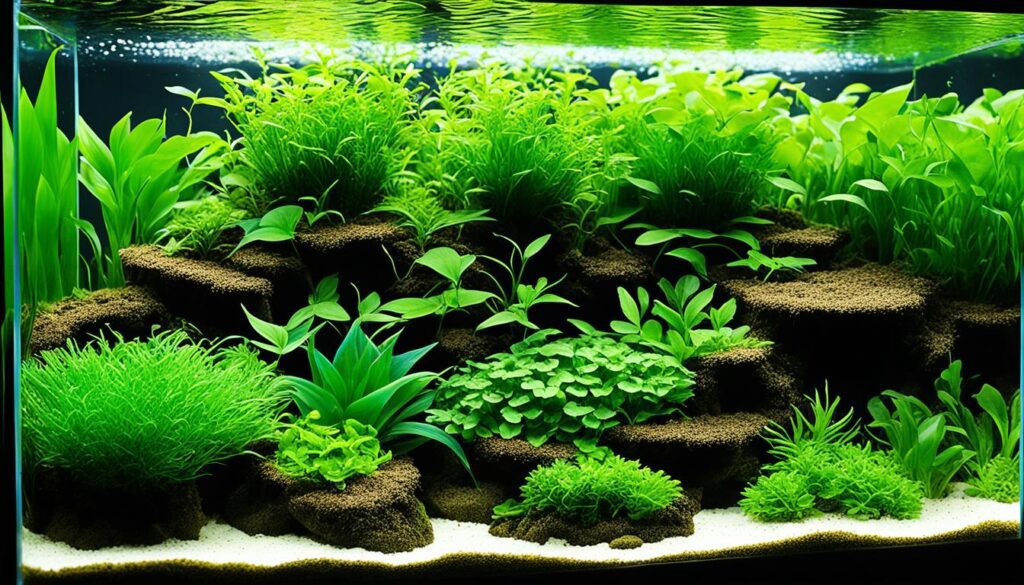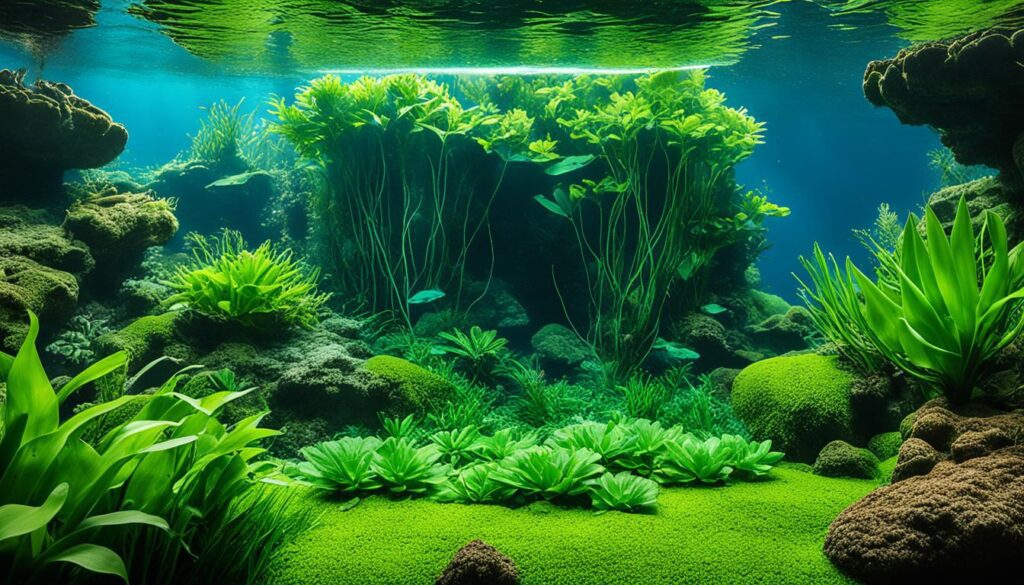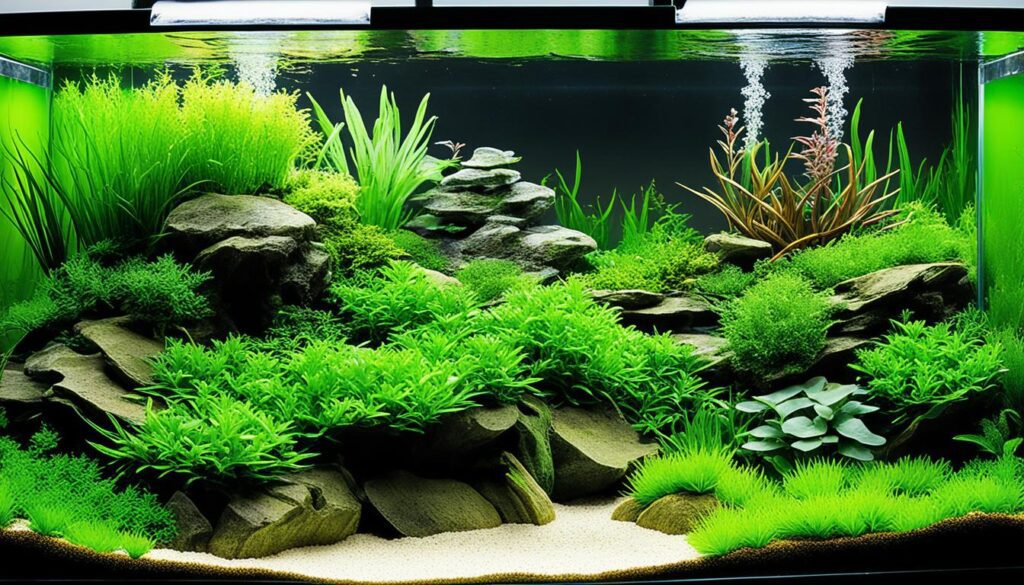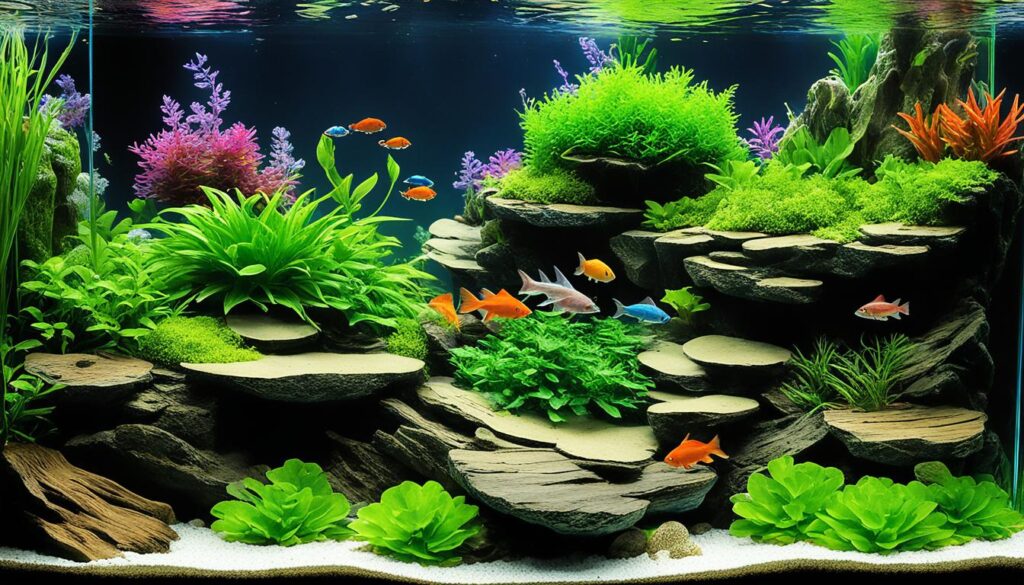Starting my aquascaping journey, I learned something important. To get optimal plant growth, the right foundation is crucial. This means choosing a good substrate that makes your aquarium look great and keeps aquatic plant health strong. I started with substrates full of nutrients, like ADA Aqua Soil or CaribSea EcoComplete. These help plants grow from the bottom up. But, beginners should try something simpler, like gravel or sand. This prevents too many nutrients from leaking and causing algae problems.
Setting up an aquarium is heavy work, almost 10 pounds per gallon with everything inside. This weight includes water, substrate, gear, and decorations. It’s a big deal, but it’s key for a lasting setup. My first tanks had 2-3 inches of substrate for plants to root well. I added root tabs for extra nutrients. And the Easy Plant LED light helped a lot, shining the perfect light for growth. The right substrate choice is a big, silent player in making a beautiful underwater world.
I’ve tried lots of plants to see what works best in my setup. Java Fern and Anubias barteri were some of my choices. Keeping the water 6 inches deep while planting helps. It protects the plants from getting damaged. This way, I aim for the best condition for optimal plant growth.
Working with the substrate in my new tanks taught me its value in supporting life. I used sources like Aquascaping Love for great tips on substrate selection. This helped me create a space where fish and plants live in harmony. For me, each aquarium is a chance to watch nature’s beauty play out.
Understanding the Role of Substrate in Aquascaping

The substrate in aquascaping does more than just look pretty. It’s critical for the health and growth of plants in your aquarium. Choosing the right substrate affects everything – from how well plants stay put to how they get nutrients. This choice is key to your aquatic garden’s success.
The Importance of Substrate for Plant Anchorage
For your plants to stay stable, the right substrate is key. It gives a sturdy base for plants like Anubias and Swordplants. These plants need to be securely rooted to grow. Particles that are 2-5 mm across are best. They keep larger plants in place, blending them with the decor.
Nutrient Circulation and Root Penetration
A good substrate is like a nutrient storehouse for plants. The right substrate choice boosts root growth with effective nutrient flow. This is essential for plants to stay healthy long-term. Aquasoils stand out because they are nutrient-rich but still let water through. This prevents common issues like bad spots and nutrient loss.
Particle Size Considerations for Different Plant Types
Choosing the right substrate size is crucial for plant success. Small plants need fine substrates to easily access nutrients. On the other hand, big plants need larger particles for stronger support. Avoid sharp substrates as they can hurt plant roots and bottom dwellers.
When picking a substrate, think about how it fits your aquascaping design and the needs of your plants. A natural, healthy substrate boosts nutrient flow, supports roots, and leads to a well-balanced aquatic garden.
The Nutritional Aspect of Your Substrate for Plant Growth

Setting up an aquarium calls for attention to its substrate. Every substrate you choose, like ADA Aquasoil or CaribSea EcoComplete, is key. These substrates are rich in aquarium substrate nutrients. They anchor plants and release essential nutrients for plant growth.
The substrate CEC (Cation Exchange Capacity) is a critical feature. It shows how well a substrate can hold and supply nutrients to the plants. A substrate with high CEC makes nutrients easily accessible to the plants. However, to keep your plants thriving, replenish the nutrients with root tabs or extra layers.
If you’re using the Walstad method, it relies on a balance of light, soil, and minimal human interference. This method is about simplicity and letting nature do its work. It integrates nutrient-rich substrates effectively.
- Maintain a substrate thickness of at least 2 inches for root growth.
- Use root taps like TerraTabs to keep the nutrients up for months.
- Choose substrates like Tropica Soil for perfect pH, GH, and KH levels, making plants healthier.
- Change the water often to keep the substrate fresh and safe from bad bacteria.
- Add Neutro T and Neutro CO2 daily for strong plant growth.
- Quickly remove any dead plant parts to keep the substrate healthy.
By balancing these factors and regularly checking the soil and nutrient levels, your aquarium will not just survive but can thrive. It will become a beautiful underwater garden. This garden will improve the look and environment of your aquarium space.
Choosing the Right Substrate for Your Aquatic Flora and Fauna

To create a thriving underwater world, choosing the right substrate is key. This choice affects everything from your water’s pH to the well-being of your fish and plants. Think about the size of the grains, the KH levels, and whether you need an inert or active substrate for your tank’s needs.
Substrate Types That Affect Water pH and Hardness
The substrate you pick can change your aquarium’s water chemistry. This matters a lot for the health of your underwater world. Active substrates like Aqua Soil are full of nutrients, which is great for plants. But they might release ammonia at first, which could affect water quality. For fish that like higher pH and KH, using crushed coral can keep them happy and healthy.
The Impact of Substrate Size on Water Chemistry
The size of your substrate grains really affects your tank. Big grains mean cleaning might be easier, but waste could pile up. This can harm water quality. Small grains look nice and are good for plant roots. But they need regular care to avoid harmful gases. Picking the right size helps keep your aquarium clean and stable for your fish and plants.
Inert vs. Active Substrates: Pros and Cons
Comparing inert substrates like gravel with active ones such as Eco Complete is interesting. Inert ones are cheaper and don’t change your water’s chemistry. But, they’re tougher for plants to grow in. Active substrates are full of nutrients plants love but watching your water closely is key.
Knowing the difference between substrates helps make your aquarium better and healthier for both plants and animals. Below, see a table that compares popular substrates:
Substrate Type |
Pros |
Cons |
|---|---|---|
Aquarium Gravel |
Cost-effective, easy to clean |
Inert, challenging for plant growth |
Eco Complete |
Pleasing appearance, high CEC |
Lacks essential nutrients, higher cost |
Aqua Soil |
Contains key nutrients, stabilizes slopes |
Can leach ammonia initially |
Mineralized Topsoil |
Cost-efficient, nutrient-rich |
Time-consuming to prepare, may need toppings |
Miracle Grow Organic |
Budget-friendly, nutrient-rich |
Messy during rescaping |
Choosing the right substrate is about more than just looks. It helps your plants and animals grow healthy and strong. It’s a big part of your aquarium’s ecosystem.
Crafting the Perfect Aesthetic with Aquarium Substrates

As an aquascaping enthusiast, the right balance in my aquarium setup is important. It not only affects the health of the aquatic environment but also the visual appeal. Let’s explore how different substrate colors and setups make a beautiful, natural aquascape.
Choosing the right substrate is more than just about function. It sets the mood and beauty of the aquarium. Dark substrates help pale or light-colored fish stand out by offering a pleasing contrast. On the other hand, light substrates can make dark fish and green plants look more vibrant.
Using different substrates creatively can make an aquascape look more natural. By creating layers or gradients, you can mimic natural underwater landscapes. This turns a simple aquarium into a captivating ecosystem. The choice of substrate also affects plant placement, crucial for the lush look of Dutch Aquariums.
- Visual Harmony: The substrate should complement rocks, driftwood, and the colors of aquatic life.
- Functional Aesthetics: Substrates aren’t just pretty. They support plant roots and help with water chemistry and clarity.
The choice of substrate is a key decision in aquascaping. It can create either a thrilling contrast or a soothing harmony. This choice sets the tone for your aquarium.
Substrate Type |
Best for Style |
Visual Impact |
|---|---|---|
Dark Substrates |
Dutch and Nature Aquariums |
Enhances lighter colored plants and animals |
Light Substrates |
Iwagumi and Jungle Style |
Makes space brighter; highlights dark colors |
To sum up, creating an inviting aquascape starts with choosing the right substrate color choices. It’s about the balance between visual appeal and functionality. This ensures your aquarium is not only beautiful but also a healthy home for its inhabitants.
Exploring Your Options: Types of Substrate for Plant Growth

Understanding various substrate types is key for lush aquascapes. Each substrate meets different needs, like nutrients, rooting, and looks. Let’s check out some top substrate options for creating your ideal underwater world.
Aquarium Substrates Ideal for Layering
Layering substrates in your aquarium is both art and science. It boosts your aquatic environment’s depth. Aquarists use gravel, sand, and nutrient layers like peat or laterite. This mix makes for a better nutrient cycle and low-maintenance aquascaping.
The Benefits of One-layer Substrates
For ease and simplicity, one-layer substrates are great. Items like Onyx and Fluorite are not only pretty but also offer some nutrient support, though they’re less rich than specialized soils. This choice is ideal for hobbyists who want low upkeep while keeping plants healthy.
Aquasoils and Their Effectiveness for Plant Sustenance
Your substrate choice greatly influences aquatic plant health and growth. Aquasoils, like ADA Amazonia and CaribSea EcoComplete, are top picks for nutrients. They help plants establish strong roots and stay healthy, even if they might need extra nutrients later. They provide a high-quality, nutrient-rich substrate foundation for your aquarium plants.
Choosing the right substrate is crucial for customized aquascaping. Whether you like detailed layers or simple setups, your aquarium’s look and plant health depend on your substrate decision. Each substrate type has its own advantages. Pick one that fits your plants’ needs and your design goals.
Type of Substrate |
Benefits |
|---|---|
Combined Substrates |
Enhanced nutrient cycling, ideal for complex plant setups |
One-layer Substrates |
Easy installation, suitable for simpler aquascapes |
Aquasoils |
High nutrient content, supports vigorous plant growth |
Step-by-Step Guide: Installing Your Aquarium Substrate
Embarking on the journey of setting up an aquarium, let’s dive into installing the substrate. Start with inert substrates for beginners. You should use 1 pound of gravel per gallon of water. This creates a layer 2-3 inches thick, perfect for planting.
Remember, tropical plants and fish need temperatures between 75 and 80°F. Keeping this climate is key for their health.
Using enriched substrates like ADA Aquasoil requires patience. After setting it up, let the ecosystem stabilize for a few weeks. This is due to potential spikes in ammonia and nitrite levels. Such steps are crucial before adding your fish.
For compound substrates, start with a base that has good cation exchange capacity (CEC). I recommend using ADA Power Sand M. Then, cap it with coarser grain to prevent nutrient loss. Top it off with fine gravel or ADA Aqua Soil Amazonia Powder for looks and functionality.
Maintaining a healthy tank goes beyond just substrate installation. Use tools like thermometers and water testing kits to keep things in check. For new planted tanks, set LED light timers to 9-10 hours a day. For my 50-gallon tank, I use 2.5 watts per gallon.
Adding ADA Bacter 100 and ADA Clear Super helps the substrate layers. It promotes a stable biological environment. Then, place red Moor wood and knife-stones carefully for a natural look and plant growth. Using an ADA Solar HQI 150W light system and CO2 setup keeps the environment balanced.
An ADA Super Jet ES-600 and Eheim Skim 350 help maintain water quality. Along with regular dosing of ADA Brighty fertilizers, my planted tank is thriving.








